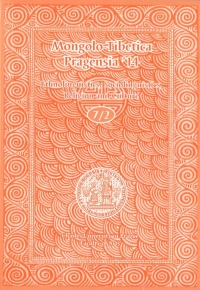Mongolo-Tibetica Pragensia ’14 Linguistics, Ethnolinguistics, Religion and Culture Volume 7, No. 2 (2014) Special Issue Indigenous Elements in Tibetan Religions

Edited by Daniel Berounský
Editors
Editors-in-chief: Jaroslav Vacek and Alena Oberfalzerová
Editorial Board:
Daniel Berounský (Charles University in Prague, Czech Republic)
Agata Bareja-Starzyńska (University of Warsaw, Poland)
Katia Buffetrille (École pratique des Hautes-Études, Paris, France)
J. Lubsangdorji (Charles University Prague, Czech Republic)
Marie-Dominique Even (Centre National des Recherches Scientifiques, Paris, France)
Marek Mejor (University of Warsaw, Poland)
Tsevel Shagdarsurung (National University of Mongolia, Ulaanbaatar, Mongolia)
Domiin Tömörtogoo (National University of Mongolia, Ulaanbaatar, Mongolia)
English correction: Dr. Mark Corner (HUB University, Brussels)
Institute of South and Central Asia, Seminar of Mongolian and Tibetan Studies, Faculty of Arts, Charles University in Prague
Celetná 20, 116 42 Praha 1, Czech Republic
http://mongolistika.ff.cuni.cz/?page=home
Publisher: Stanislav Juhaňák – TRITON
Vykáňská 5, 100 00 Praha 10
Registration number of MK ČR E 18436
ISSN 1803-5647
For acquisition please contact books@ff.cuni.cz
Contents
Daniel Berounsky
Preface
Charles Ramble (EPHE/CRCAO Paris)
Real and imaginary Tibetan chimeras and their special powers
Animals that transgress culturally-sanctioned taxonomic boundaries are often the object of special beliefs. Tibetan ritual texts, especially those of the so-called ‘Lower Vehicles’ of Bon, sometimes feature semi-divine animals that play an important role as protectors. These creatures, though natural, are perceived as concatenations of the body-parts of numerous other natural species, and may be understood as different varieties of chimera. The two examples considered here are the bat and the camel. In addition to real animals the literature also features imaginary creatures that exhibit the physical or behavioural characteristics of several natural species. Each of the animals that provides a component is presented as wielding a specific type of capability, and it is the concentration of these multiple capabilities that gives the chimera, whether real or imaginary, its extraordinary power. While the particular form that the cult of these chimeras takes may be indigenous to Tibet, the similarities they bear to the divinities of Tantric Buddhism may ultimately have led to the usurpation of their role and their marginalisation.
Robert Mayer (University of Oxford)
Indigenous elements in Tibetan tantric religion
This paper is an attempt at an overview of the still only partially understood topic of indigenous elements within Tibetan tantric religion, with particular focus on the underlying historical and cultural dynamics. Drawing on the research Cathy Cantwell and I have done together in recent years, and above all greatly indebted to the discoveries of many other scholars, it was inspired by the need to communicate the topic to non-specialist academic colleagues, on the one hand avoiding excessive technical obscurantism, but on the other hand utilising up to date research.
Daniel Berounský (Charles University)
Tibetan myths on “good fortune” (phya) and “well-being” (g.yang)
The paper focuses on mythical narrations associated with the ritual of summoning “good fortune” (phya) and “well-being” (g.yang). These myths stem from the non-Buddhist ritual tradition of Tibet. Firstly, their great variety inside the tradition of Bon attests to the heterogeneity of this religious tradition. Secondly, it reveals particular ways in which non-Buddhist ritual practice has been adapted in the case of its Buddhist versions. Although this ritual is originally non-Buddhist, one should assume that the concepts underlying it could have common features shared with peoples from the wider territory of Central Asia.
Dan Martin (Jerusalem)
The Gold Drink rite. Indigenous, but not simply indigenous
The rite known in Tibetan as the Gold Drink (gser-skyems) is one that has hardly received sustained attention in earlier literature about Tibet, although brief mentions are many and some paragraphs have been written on it. The chief hypothesis of this essay is that it merits investigation as one of a number of rites and ritual objects wholly or largely indigenous to the Himalayan Plateau region, with the proviso that it may be indigenous to surrounding areas as well. Future studies will ideally take much more ethnographic and archaeological evidence into account.
Roberto Vitali (Dharamshala, Indiana University)
“Indigenous” vis-ŕ-vis “foreign” in the genesis of Tibet’s ancestral culture
This paper examines the pale signs found in the Tibetan literature concerning the genesis of Tibet’s ancestral culture. It focuses on significant passages of the documents (collectively known as rus mdzod) dedicated to the various ancestral tribes that, in a probably long evolutive process, formed the Tibetan race. This analysis aims at establishing whether the cultural process that led these tribes introduce expressions of their own civilisation on the Tibetan highlands should be considered indigenous or foreign.

